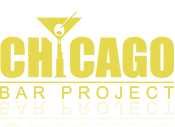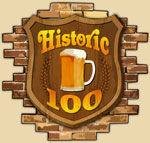“Sophisticated Informality”
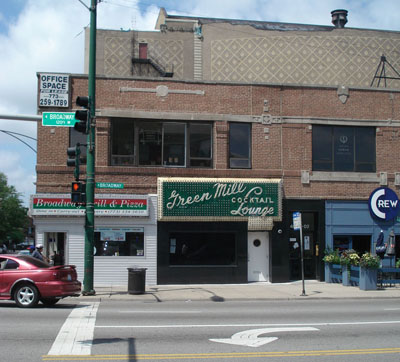 Now over 100 years old, the Green Mill Cocktail Lounge is the crown jewel of Chicago’s Uptown neighborhood and is the best jazz club in the known universe. Green Mill is a place for people of all walks of life to relax, enjoy martinis or Schlitz, and listen to some of the best music around, from traditional jazz to swing orchestras. The Green Mill even hosts the longest running poetry slam, every Sunday night. Inspired by the Moulin Rouge in Paris (Red Mill), the Green Mill has attracted many celebrities through the years from Al Capone to Frank Sinatra to Bill Gates and has been filmed in The Untouchables, High Fidelity, and the 80s TV series, Crime Story. This is particularly impressive considering that Uptown has gone through an incredible transformation from its origins as a swamp to the “Hollywood of the Midwest” with Charlie Chaplin, to being run by Al Capone, to a haven for drug addicts and hoodlums, and finally to a neighborhood being reborn. After much resistance, Uptown has finally succumbed to the regentrification surrounding it for the past 15 years now that Starbucks moved in. Nearby Aragon Ballroom and Riviera Theatre are both going strong after recent renovations, Borders has also moved into the rehabilitated Goldblatt’s Building, and a few other cocktail lounges like Fat Cat and the Uptown Lounge have opened in the area to create a respectable entertainment district in Uptown. One has to wonder if this would have been possible if owner Dave Jemilo hadn’t rescued the Green Mill from squalor in 1986 and restored its former luster, both in terms of décor and in hosting the best jazz around – a tradition that dates back to the club’s beginning, so many moons ago. Whatever the case, you can always count on a great time, 1940s style, at the Green Mill.
Now over 100 years old, the Green Mill Cocktail Lounge is the crown jewel of Chicago’s Uptown neighborhood and is the best jazz club in the known universe. Green Mill is a place for people of all walks of life to relax, enjoy martinis or Schlitz, and listen to some of the best music around, from traditional jazz to swing orchestras. The Green Mill even hosts the longest running poetry slam, every Sunday night. Inspired by the Moulin Rouge in Paris (Red Mill), the Green Mill has attracted many celebrities through the years from Al Capone to Frank Sinatra to Bill Gates and has been filmed in The Untouchables, High Fidelity, and the 80s TV series, Crime Story. This is particularly impressive considering that Uptown has gone through an incredible transformation from its origins as a swamp to the “Hollywood of the Midwest” with Charlie Chaplin, to being run by Al Capone, to a haven for drug addicts and hoodlums, and finally to a neighborhood being reborn. After much resistance, Uptown has finally succumbed to the regentrification surrounding it for the past 15 years now that Starbucks moved in. Nearby Aragon Ballroom and Riviera Theatre are both going strong after recent renovations, Borders has also moved into the rehabilitated Goldblatt’s Building, and a few other cocktail lounges like Fat Cat and the Uptown Lounge have opened in the area to create a respectable entertainment district in Uptown. One has to wonder if this would have been possible if owner Dave Jemilo hadn’t rescued the Green Mill from squalor in 1986 and restored its former luster, both in terms of décor and in hosting the best jazz around – a tradition that dates back to the club’s beginning, so many moons ago. Whatever the case, you can always count on a great time, 1940s style, at the Green Mill.
The Early Days
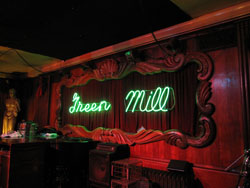 The Green Mill began its life long ago in 1907 as Pop Morse’s Gardens, alternatively known as Pop Morse’s Roadhouse. At this time Uptown was actually part of a town called Lake View, and Pop Morse’s was a popular destination, particularly with its large sunken beer garden, for Chicagoans visiting St. Boniface’s Cemetery at Clark and Lawrence. In 1910, the enterprising Tom Chamales bought the establishment from Pop Morse, added outdoor dancing and entertainment in an enlarged sunken garden, installed the “Rhumba Room” on the second floor, and constructed a large green windmill on the roof to go along with its new name, the “Green Mill Gardens.” The choice of the name “Green Mill” was inspired by the infamous Moulin Rouge in Paris (French for “red mill”) and “green” was chosen to avoid confusion with any establishments in the red light districts around town. Tom Chamales later went on to construct the Riviera Theater around the corner from the Green Mill Gardens. Around that time, Uptown was also known as the “Hollywood by the Lake,” and the Green Mill Gardens was more of a roadhouse spanning the entire block than a cocktail lounge. Back then, Charlie Chaplin himself used to come in for a drink after working at Essanay Studios on Argyle.
The Green Mill began its life long ago in 1907 as Pop Morse’s Gardens, alternatively known as Pop Morse’s Roadhouse. At this time Uptown was actually part of a town called Lake View, and Pop Morse’s was a popular destination, particularly with its large sunken beer garden, for Chicagoans visiting St. Boniface’s Cemetery at Clark and Lawrence. In 1910, the enterprising Tom Chamales bought the establishment from Pop Morse, added outdoor dancing and entertainment in an enlarged sunken garden, installed the “Rhumba Room” on the second floor, and constructed a large green windmill on the roof to go along with its new name, the “Green Mill Gardens.” The choice of the name “Green Mill” was inspired by the infamous Moulin Rouge in Paris (French for “red mill”) and “green” was chosen to avoid confusion with any establishments in the red light districts around town. Tom Chamales later went on to construct the Riviera Theater around the corner from the Green Mill Gardens. Around that time, Uptown was also known as the “Hollywood by the Lake,” and the Green Mill Gardens was more of a roadhouse spanning the entire block than a cocktail lounge. Back then, Charlie Chaplin himself used to come in for a drink after working at Essanay Studios on Argyle.
Al Capone, Prohibition and the Gangster Era
The Green Mill is best known for serving as a gangster hangout and speakeasy during Prohibition. During this time, the Green Mill was leased by the Chamales Brothers to the mob, including James Vincenzo (Gebardi) DeMora – better known as Jack “Machine Gun” McGurn – who held a quarter stake in the club. McGurn is suspected of being the primary gunmen in the St. Valentine’s Day Massacre that took place behind a garage on Clark Street (next to present-day Clark Bar), though he was never charged.
Jack McGurn happened to work for a one, Alfonse “Scarface” Capone – perhaps you’ve heard of him?… The Green Mill become a favorite for this most infamous of Chicago mobsters. Capone actually owned a speakeasy in the basement of a building across the street but preferred the Green Mill because it was operating openly, thanks to a pay-off to the police, and because of his favorite singer, Joe E. Lewis. Lewis was so good that he was paid an outlandish $650 per week by the Green Mill. When the New Rendezvous Club opened downtown and offered him $1,000 per week to play there, Lewis took it against the orders of Jack McGurn. Three days after he left, McGurn is also said to have ordered his henchmen to exact revenge on Lewis, who slashed his throat, cut of part of his tongue and left him for dead in his dressing room. Ironically, Louis recovered from his injuries and returned to perform as a comic at the Green Mill, while Jack McGurn was gunned down by rival mobsters almost seven years to the day from the St. Valentine’s Day Massacre. The event is commemorated on a large, wooden carving above the bar that cheekily describes what happened, and the story of Joe E. Lewis become the subject of The Joker is Wild (1957), starring another performer that knew something about the mafia, Frank Sinatra.
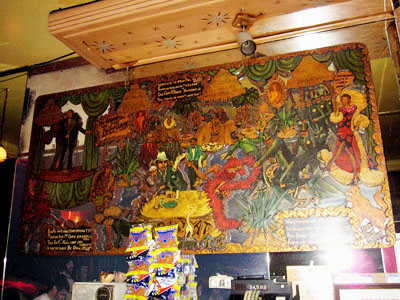
“Big Al was ingesting spaghetti;
Machine Gun McGurn, surprisingly still
Said to Joe E, “You’ll look like confetti
If you try to leave the Green Mill.”– excerpt from the wooden carving behind the bar at the Green Mill
 Each night when Capone entered the bar, the bandleader would stop whatever they were playing and performed Capone’s favorite, “Rhapsody in Blue.” Capone would then take his favorite seat in the booth across from the side door on Lawrence and at the end of the bar. In this way, Capone could clearly see whoever entered the bar from either door, be it friend, foe or the police. In addition to Joe E. Lewis, one could hear such performers as Billie Holiday, Tommy Dorsey, Sophie Tucker, Al Jolson, Bix Beiderbecke, Jack Teagarden, and Benny Goodman at the Green Mill. The combined notoriety of these and other characters made the Green Mill the subject and location for movies like The Untouchables, Thief, Prelude to a Kiss, Family Thing, Next of Kin, and the television series, Crime Story. Both Al Capone and hit man “Machine Gun” Jack McGurn are remembered in photographs behind the bar.
Each night when Capone entered the bar, the bandleader would stop whatever they were playing and performed Capone’s favorite, “Rhapsody in Blue.” Capone would then take his favorite seat in the booth across from the side door on Lawrence and at the end of the bar. In this way, Capone could clearly see whoever entered the bar from either door, be it friend, foe or the police. In addition to Joe E. Lewis, one could hear such performers as Billie Holiday, Tommy Dorsey, Sophie Tucker, Al Jolson, Bix Beiderbecke, Jack Teagarden, and Benny Goodman at the Green Mill. The combined notoriety of these and other characters made the Green Mill the subject and location for movies like The Untouchables, Thief, Prelude to a Kiss, Family Thing, Next of Kin, and the television series, Crime Story. Both Al Capone and hit man “Machine Gun” Jack McGurn are remembered in photographs behind the bar.
Though these Green Mill personalities have passed on, the place still has some of its speakeasy legacy. The trapdoor is still there behind the bar, where a hydraulic elevator once brought up illicit liquor to booze-thirsty patrons, and led to a series of tunnels under the building that were used for trafficking booze, card games and gambling, and to vacate the Green Mill on short order. This interesting mechanism is similar to the one that used to be at John Barleycorn’s, another classic Chicago bar, gangster hangout and former speakeasy. In those days, you had to wear a tuxedo or evening gown just to get inside, and people smuggled in alcohol in hollowed-out canes and hidden flasks.
Uneasy Times in Uptown
Following McGurn’s reign of terror, the end of Prohibition and Al Capone’s imprisonment, the Green Mill was acquired by the Batsis Brothers in 1942 who owned it until sometime in the 1960s. Their legacy can be found in the Green Mill’s present day décor, following its remodeling to accommodate that wondrous invention known as “air conditioning.” During this stretch, the Green Mill continued to attract upscale patrons, including Frank Sinatra (when he wasn’t at Twin Anchors in Old Town). Beginning with the start of the Depression, the Uptown neighborhood began to gradually decline. The club was purchased in 1960 from Steve Brend, also known as “The Mayor of Uptown” because of his open friendliness and first-hand knowledge of the gangster era. Brend moved to Chicago in 1935 and was hired by Jack McGurn himself. Between the 1960s and 1980s, the neighborhood gradually declined. This was due primarily to the pimps and drug dealers that infested the area, and a change in patronage from wealthy to working class to poor immigrants. During this dark period, a methadone clinic was opened next door, and the legendary jazz club deteriorated into a mere shadow of the successful restaurant, roadhouse and cocktail lounge that it had been.
Renaissance at the Green Mill
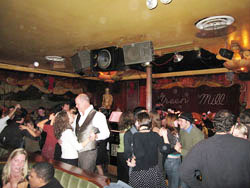 Fortunately, the Green Mill was purchased and rehabilitated in 1986 by current owner, Dave Jemilo who owned Déjà Vu in Lincoln Park and really got into jazz following the advent of his the Sunday night jazz jam sessions he hosted there. Dave purchased the Green Mill from Steve Brend and, since then, the Green Mill has enjoyed a cultural rebirth by attracting some of the best jazz performers in the country, hosting Chicago’s leading slam poets, and patrons old and young alike that appreciate the Green Mill’s rich and vibrant history. Recently, the Mill has been featured once again in movies like Kissing a Fool (with local David Schwimmer), and High Fidelity in the scene where native Evanstonian John Cusack illustrates the five reasons that his girlfriend broke up with him. Today, the Green Mill has the distinction of being the oldest, continuously running jazz club in the country. A five-inch tall, leather-bound scrapbook behind the bar contains much of this intriguing history in clippings from almost every major magazine and newspaper in the country.
Fortunately, the Green Mill was purchased and rehabilitated in 1986 by current owner, Dave Jemilo who owned Déjà Vu in Lincoln Park and really got into jazz following the advent of his the Sunday night jazz jam sessions he hosted there. Dave purchased the Green Mill from Steve Brend and, since then, the Green Mill has enjoyed a cultural rebirth by attracting some of the best jazz performers in the country, hosting Chicago’s leading slam poets, and patrons old and young alike that appreciate the Green Mill’s rich and vibrant history. Recently, the Mill has been featured once again in movies like Kissing a Fool (with local David Schwimmer), and High Fidelity in the scene where native Evanstonian John Cusack illustrates the five reasons that his girlfriend broke up with him. Today, the Green Mill has the distinction of being the oldest, continuously running jazz club in the country. A five-inch tall, leather-bound scrapbook behind the bar contains much of this intriguing history in clippings from almost every major magazine and newspaper in the country.
“Step up! Step in!” barks the doorman on a busy night. All is forgiven when you pay a modest six bucks to get in, and you step back into the 1940s. Grab a martini, Manhattan or Schlitz at the bar and then scramble for a seat. The Green Mill is decorated uniquely in the art deco style. Long, ornately wooden-framed murals of mountain, countryside and seashore landscapes cover the walls, including one with a windmill – like the one that used to be on Pop Morse’s roof. A bright neon sign with “Green Mill” written in cursive script hangs behind the band, next to the white statue, illuminating the room in a green glow. The high-backed booths are crescent shaped with gold velvet seat backs and white tablecloths. The booth to the right of the bar and across from the side door is where Al Capone used to sit so that no one could walk in either front or the side without him noticing. There are more tables and booths up front near the band, but get there before 8:00 p.m. or after 12:30 a.m. if you want a seat, even during the week as the capacity of the Green Mill is only rated at 150.
“Please be quiet during the performances,” is asked of you at the door, on little cards that are passed out, and the staff will give you dirty looks if you talk in anything above a whisper. If you continue to talk, you will be openly shushed by the bartender or staff. It causes one to wonder: is the Green Mill a bar or a library? The wooden, shell-shaped, light fixtures mounted on the ceiling are so big that they could crush a man if they ever fell. Four poles holding up the ceiling are decorated in both mirrored and black & white.
Behind the bar stands a bronze Schlitz statue, complete with a lighted Schlitz globe logo, and a sign above the bar proclaiming, “Niema Schlitza, niema piwa,” which means, “When you outta Schlitz, you outta beer.” Schlitz used to be the house favorite until it was no longer available in kegs. You can still get Schlitz in bottles, but Pabst Blue Ribbon is now on tap. A baby grand piano can also be found behind the bar, located in a large curved space that serves as a second stage for smaller, combo jazz bands. It was here that I was once tortured by the voice of a woman who could neither talk or sing in English, which would have been fine if it was an acid jazz performance. In addition to Schlitz, the Green Mill is the perfect place for a martini, Manhattan, Long Island Iced Tea, or Amaretto stone sour. If you order one of these, you better like mixed drinks because they’re bound to be strong. And be forewarned: the bathrooms are located right next to the band. So, if the place is busy and there is a line to the john, you may become part of the performance.
The Continued Jazz Legacy
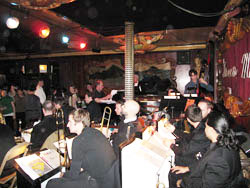 Live music has been playing at the Mill every night since 1942 with acts ranging from jazz, blues, piano, big band orchestras, and swing bands. The Jimmy Sutton Four Charms plays on Tuesdays, and the Alan Gresik Swing Shift Orchestra plays on Thursdays. When swing was revived in the mid-90s, the Mighty Blue Kings got their start at the Green Mill by playing Tuesday nights. They have since released a song called “Jumpin’ at the Green Mill” to commemorate those days. On Fridays, the baby grand piano fuels the “Cocktail Hour Show,” which is free and runs from 5:00 to 8:00 p.m. On Saturdays after 1:00am is the “After Hours Jazz Party, when the Sabertooth Jazz Quintet takes over, as they have been since 1996. Visiting national artists on the weekends include sax player David Liebman, vocalists Kurt Elling, Sheila Jordan and Mark Murphy, pianist Henry Butler, and the Either/Orchestra. In addition to live music, the Green Mill has one of the best jukeboxes in the city. The juke is filled with classic jazz records, pre-dating the 1960s, many of which are no longer in print.
Live music has been playing at the Mill every night since 1942 with acts ranging from jazz, blues, piano, big band orchestras, and swing bands. The Jimmy Sutton Four Charms plays on Tuesdays, and the Alan Gresik Swing Shift Orchestra plays on Thursdays. When swing was revived in the mid-90s, the Mighty Blue Kings got their start at the Green Mill by playing Tuesday nights. They have since released a song called “Jumpin’ at the Green Mill” to commemorate those days. On Fridays, the baby grand piano fuels the “Cocktail Hour Show,” which is free and runs from 5:00 to 8:00 p.m. On Saturdays after 1:00am is the “After Hours Jazz Party, when the Sabertooth Jazz Quintet takes over, as they have been since 1996. Visiting national artists on the weekends include sax player David Liebman, vocalists Kurt Elling, Sheila Jordan and Mark Murphy, pianist Henry Butler, and the Either/Orchestra. In addition to live music, the Green Mill has one of the best jukeboxes in the city. The juke is filled with classic jazz records, pre-dating the 1960s, many of which are no longer in print.
Uptown Poetry Slam
The Green Mill is also notable for starting the first poetry slam in 1986, officially known as the “Uptown Poetry Slam,” that now takes place every Sunday from 7:00pm to 10:00pm. A $6 cover charge gets you in to see amateur poets perform modern slam poetry and compete for the favor of the audience. Each night, 2-8 contestants are selected to compete and three judges are picked from the audience to rate the poems on a scale of 1-10. Each poet-contestant is matched against another, and each reads a poem. The poet with the highest rating goes on to compete again. Each poet reads a maximum of three poems, none over three minutes long. The winning poet chooses between $10 and the “Big John Scam” consisting of five lottery tickets. One interesting twist to the poetry: the audience as a whole is encouraged to “participate.” If the poetry is appreciated, the audience should stay quiet and clap at the end. If not, the audience is instructed to snap their fingers, stomp their feet and boo depending on how bad the poet is and how long he tries to continue reciting. Brendan Moore wrote about it in his Green Mill article that appeared in the February 2003 edition of The Tap:
“A new-age beatnik-type from L.A. takes the stage, and tells the audience he’ll be reading his prose in a John Lennon-sounding voice, as he believes this does the most justice to his rhymes. The poet is on shaky ground from the word go as he begins speaking in a butchered British accent. A skeptical crowd grants him a grace period of a minute, but no more, before they decide this act would have been better off left in Tinsel Town. The heckling starts softly in the form of snapping fingers and hissing before the unabashed dive into their arsenal of creative taunts and jeers. ‘Where’s Yoko, jackass?’ one spectator yells from the front booth. The host puts him out of his misery grabbing the mic, as the band launches into a satirical version of ‘Imagine.”
Many of these poets come week after week, and can be seen performing additional slam poetry on the sidewalk afterwards. If you can’t get enough on Sunday night, check out the slam poetry going on at Weeds Tavern every Monday night.
Patricia Barber
The Green Mill “Slam” is followed by the popular jazz pianist and vocalist, Patricia Barber, when she’s not on tour. Barber got her start at the Gold Star Sardine Bar and moved on to the Green Mill after it closed. Due to her popularity following the Green Mill’s Sunday Night Slam, Patricia Barber has been touring extensively on the road. As of April 2003, Patricia was awarded a Guggenheim fellowship, which is given to some of the brightest talent in the country, and has been playing at the Green Mill on Monday nights when she’s not on the road. Be sure to check her out at the Green Mill if you can, otherwise I recommend that you pick up a copy of café blue, Patricia Barber Companion (recorded at the Green Mill) or her first album, Nightclub. All three are excellent albums and should be included in the collection of any jazz aficionado.
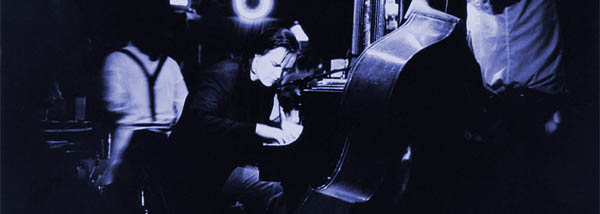
Photo courtesy of Valerie Booth O
And if That Weren’t Enough…
As if the Green Mill lacked intrigue, it may also be haunted. According to a Red Eye article, ” Bartender Laura Castro never believed this Uptown club was haunted until, working alone in the bar, she found a bottle cap, straw and cocktail sword neatly arranged atop a stack of papers she had set down moments before. A psychic has identified three resident ghosts: a woman who likes to sit on the piano; a former employee; and a flirtatious former regular who repeatedly makes a grand entrance through the front door hoping someone will notice,” (“Pints and Poltergeists; Grab a Drink–if You Dare–at Chicago’s Most Haunted Watering Holes” by Heather Shouse and Jessica Volpe, October 29, 2003).
A Few Tips for the Savvy Patron
Although in Uptown, getting there and back should not be a big deal from other parts of the city. Cabs are always out front, it is only a few blocks from the Lawrence Red Line El stop, and there is plenty of street parking available. Keep in mind that the neighborhood is still a bit rough. If you drive, please don’t drink. I have seen a few cars that have rammed El abutments and parked cars, and it’s not pretty to say the least. Additionally, the Aragon Ballroom and Riviera Theatre are both located close by, so go for a drink at the Green Mill before or after seeing Cheap Trick or the Black Crows when they’re in town. And, when you’re looking for late-night action, skip Nick’s Uptown and Carol’s and head to the Green Mill instead, which is open until 4:00am (5:00am on Saturday). If you like jazz in Chicago, you may also want to check out Jazz Showcase, BackRoom, Andy’s Jazz, and the Empty Bottle on Wednesday nights.
“Mr. Jemilo fondly recalls the night he and jazz singer Sarah Vaughn ‘got drunk together,’ and ‘the Monday night I was working the door and Microsoft mogul Bill Gates came in with five guys after a Bears game.’ Told that there was a $3 cover charge, Mr. Gates ‘pulls out three singles and gives them to me. They were sitting around drinking and having a good time and I think he liked the fact that he had to pay the three dollars.'”
– excerpt from “Jazz Joint Still Jives” by James C. Roberts of the Washington Times (May 11, 2007)
So There You Have It
The Green Mill is the best jazz club in the known universe and a living piece of Chicago history. No wonder it has been filmed so often, from High Fidelity to Ocean’s Twelve (as part of “The Night Club Scene”). While visiting the Slammo Chicago website, I ran across the following quote which sums it all up, “Is this where you go when you die, if you’re good?” For more information, check out the Green Mill website. Now keep it down, the band’s coming on.
“A buzz of silent expectation weaves
as the man who looks like a Joe
sits at the piano. A note
stirs the murky air,
ringing.”– excerpt from The Green Mill by Lisa Rathje (Spring 1999 edition of The Castle Literary Magazine)
